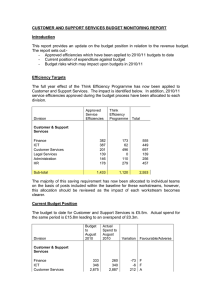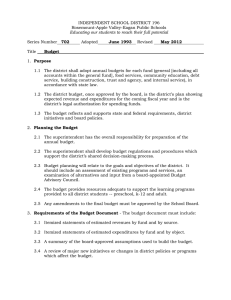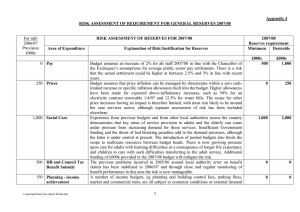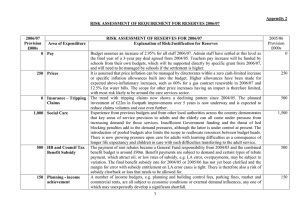CUSTOMER & SUPPORT SERVICES BUDGETARY CONTROL REPORT Budget Monitoring 2010/11
advertisement
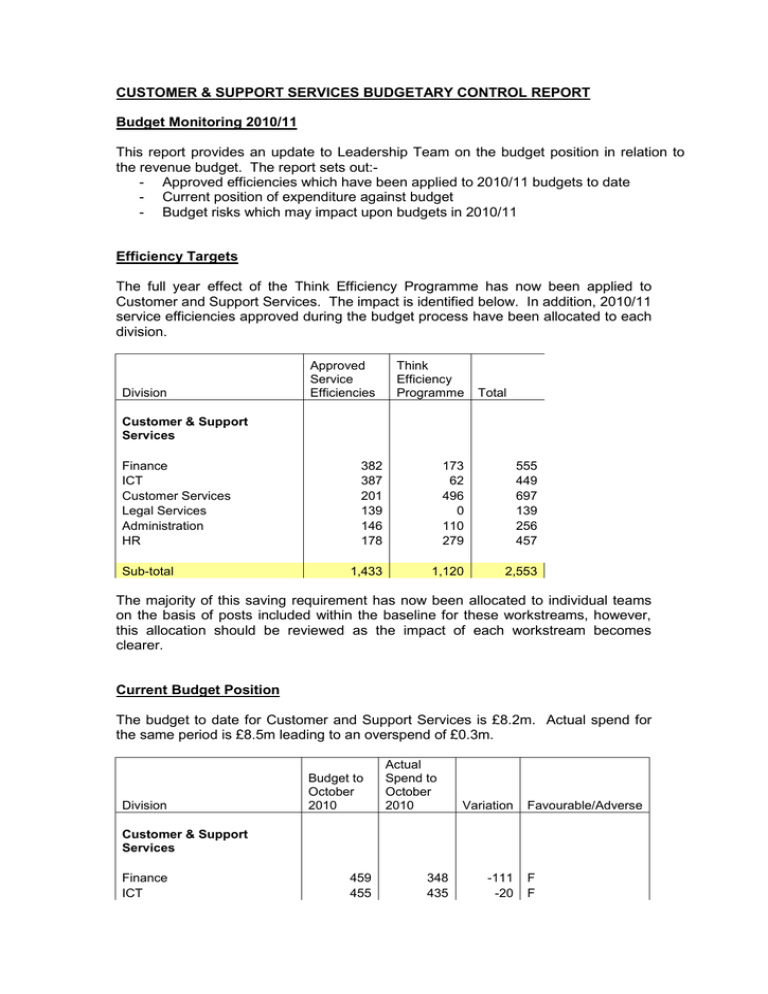
CUSTOMER & SUPPORT SERVICES BUDGETARY CONTROL REPORT Budget Monitoring 2010/11 This report provides an update to Leadership Team on the budget position in relation to the revenue budget. The report sets out:- Approved efficiencies which have been applied to 2010/11 budgets to date - Current position of expenditure against budget - Budget risks which may impact upon budgets in 2010/11 Efficiency Targets The full year effect of the Think Efficiency Programme has now been applied to Customer and Support Services. The impact is identified below. In addition, 2010/11 service efficiencies approved during the budget process have been allocated to each division. Division Approved Service Efficiencies Think Efficiency Programme Total Customer & Support Services Finance ICT Customer Services Legal Services Administration HR Sub-total 382 387 201 139 146 178 173 62 496 0 110 279 555 449 697 139 256 457 1,433 1,120 2,553 The majority of this saving requirement has now been allocated to individual teams on the basis of posts included within the baseline for these workstreams, however, this allocation should be reviewed as the impact of each workstream becomes clearer. Current Budget Position The budget to date for Customer and Support Services is £8.2m. Actual spend for the same period is £8.5m leading to an overspend of £0.3m. Division Budget to October 2010 Actual Spend to October 2010 Variation Favourable/Adverse Customer & Support Services Finance ICT 459 455 348 435 -111 -20 F F Customer Services Legal Services Administration HR 4,254 234 3,061 -270 4,557 193 3,161 -242 303 -41 100 28 A F A A Sub-total 8,193 8,452 259 A Administration The adverse variation relating to administration mainly relates to staff costs. Budget transfers have been made between Customer and Support Services and other directorates, however, a shortfall remains due to the establishment of the campus manager posts. Following the recent exercise undertaken to identify proposals to reduce this overspend the adverse variation relating to Administration has reduced from £126k in the last report to £100k. It is anticipated that there may be further opportunities to address overspends with the transfer of both the Turnpike and Minerva campus’. HR The adverse variation relating to HR is also linked to staff costs. The proposed efficiencies linked to the Safe Employment Team and revised working arrangements between HR and the Payroll service have not yet been achieved. It is unlikely that these savings will be achieved in full during 2010/11, however, a number of proposals have been developed to address this shortfall which were detailed in last month’s budget monitoring report. The impact of these is reflected in the reduction of the overspend from £53k last month to the current level of £28k. Customer Services The adverse variation for Customer Services relates mainly to three areas:Staffing costs - Substantial reductions were made in staffing budgets to reflect Think Efficiency savings. To date this saving has not been achieved in full and work is continuing on the Customer Services workstream. Contact Centre income – There have been a number of negotiations with external customers concerning charges raised for Contact Centre services. Whilst these have now been resolved there has been an adverse impact upon the income budgets for the Contact Centre. It is anticipated that the on-going full year effect will be reduced income of approximately £50k, however in 2010/11 there is an additional loss of income (approximately £80k) relating to prior year adjustments to charges. Supplies and Services - There are overspends across a range of supplies and services areas such as printing and postage. A number of proposals were identified to address this overspend. It has been assumed that the costs of the new NNDR system will be capitalised (this is reflected in the figures above). It was also indicated that income relating to HB subsidy would potentially exceed the budgeted levels which could then offset these budget pressures. Additional work is being done to provide a more accurate estimate of HB subsidy – this will be included in the next monitoring statement. Budget Risks There are a number of risks associated with the budget. These broadly cover our ability to raise income to support the services (through either grant or fees and charges) and our ability to control expenditure (especially in line with the efficiency targets allocated to budgets). These budget risks include: The PCT/CHSC would not agree to the initial proposal to charge for the use of Gateway rooms which means that the approved saving of £50k will not be achieved. A revised estimate has been included within budget projections however it is not yet clear how much income will be achieved. Efficiencies have not been fully implemented for TE streams such as Customer Services and Strategy, Policy & Performance. This could lead to an overspend against the budget provision. Expenditure linked to overtime is exceeding budget targets in both Customer Services and Admin. See attached appendix for an analysis of overtime expenditure. Additional income related to HR SLAs to schools is currently being reviewed to determine whether the increased income target of £97k will be achieved. Initial estimates suggest that there is a potential shortfall of £20k Potential reductions in other grant income (eg home office, hmrf) could leave both services with a shortfall. Recommendations In order to address some of the budget risks identified above it is recommended that:- Action needs to be taken to ensure approved savings for 2010/11 will be achieved. Savings implementation plans should continue to be monitored and reported to Leadership Team meetings. - Any reduction in income from external SLAs e.g. City West, Salix needs to be offset by reduction in costs or by the generation of other income - Managers should ensure only essential overtime is worked. - Staffing costs should be closely controlled and careful consideration should be given to filling vacant posts. - Ensure all supplies and services expenditure is strictly controlled in line with the revised guidance on discretionary expenditure agreed by Corporate Management Team and Budget and Efficiency Group.
